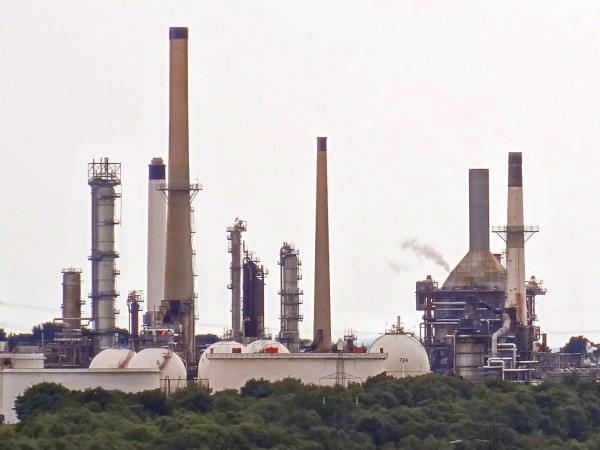 OPEC members agreed on 30 November 2016 to reduce their total oil output by 1.2m barrels per day (b/d) from January 2017 – the first OPEC cut since 2008. The biggest cut (0.49m b/d) is to be made by Saudi Arabia.
OPEC members agreed on 30 November 2016 to reduce their total oil output by 1.2m barrels per day (b/d) from January 2017 – the first OPEC cut since 2008. The biggest cut (0.49m b/d) is to be made by Saudi Arabia.
Russia has indicated that it too might cut output – by 0.3m b/d. If it carries through with this, it will be the first deal for 15 years to include Russia. OPEC members hope that non-OPEC countries will also cut output by 0.3m b/d. There will be a meeting between OPEC and non-OPEC members on 9 December in Doha to hammer out a deal. If all this goes ahead, the total cut would represent nearly 2% of world output.
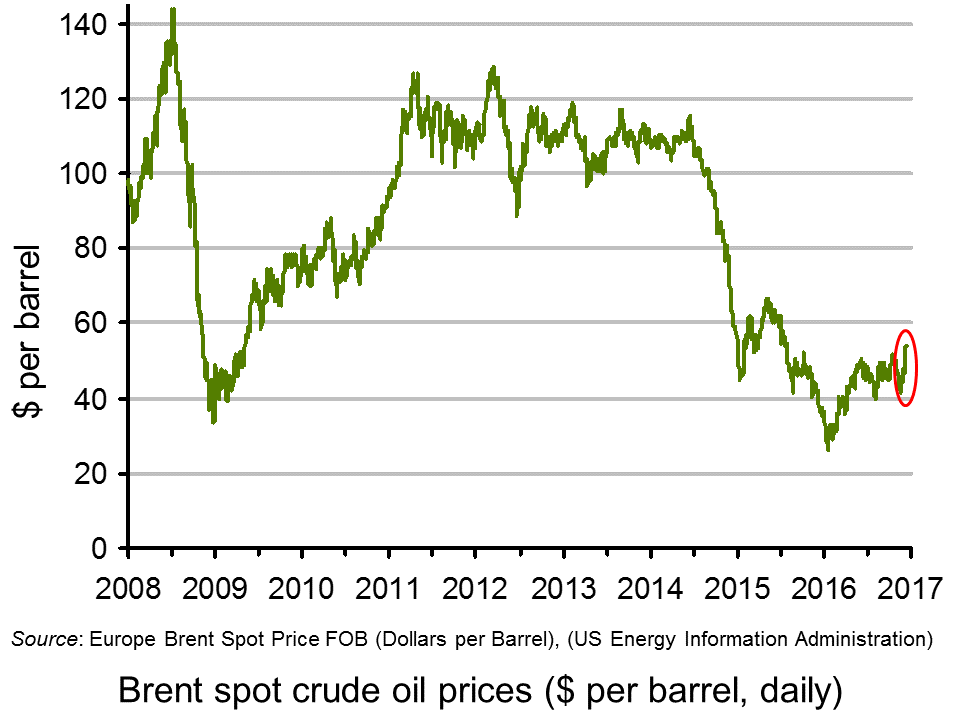 The OPEC agreement took many commentators by surprise, who had expected that Iran’s unwillingness to cut its output would prevent any deal being reached. As it turned out, Iran agreed to freeze its output at current levels.
The OPEC agreement took many commentators by surprise, who had expected that Iran’s unwillingness to cut its output would prevent any deal being reached. As it turned out, Iran agreed to freeze its output at current levels.
Although some doubted that the overall deal would stick, there was general confidence that it would do so. Markets responded with a huge surge in oil prices. The price of Brent crude rose from $46.48 per barrel on 29 November to $54.25 on 2 December, a rise of nearly 17% (click here for a PowerPoint of the chart)..
 The deal represented a U-turn by Saudi Arabia, which had previously pursued the policy of not cutting output, so as to keep oil prices down and drive many shale oil producers out of business (see the blog, Will there be an oil price rebound?)
The deal represented a U-turn by Saudi Arabia, which had previously pursued the policy of not cutting output, so as to keep oil prices down and drive many shale oil producers out of business (see the blog, Will there be an oil price rebound?)
But if oil prices persist above $54 for some time, many shale oil fields in the USA will become profitable again and some offshore oil fields too. At prices above $50, the supply of oil becomes relatively elastic, preventing prices from rising significantly. As The Observer article states:
It is more likely that a $60 cap will emerge as the Americans, who stand outside the 13-member OPEC grouping, unplug the spigots that have kept their shale oil fields from producing in the last year or two.
… The return to action of once-idle derricks on the Texas and Dakota plains is the result of efficiency savings that have seen large jobs losses and a more streamlined approach to drilling from the US industry, after the post-2014 price tumble rendered many operators unprofitable. Only a few years ago, many firms struggled to make a profit at $70 a barrel. Now they can be competitive at much lower prices, with many expecting $50 for West Texas Intermediate – a lighter crude that typically earns $5 a barrel less than Brent.
OPEC as a cartel is much weaker than it used to be. It produces only around 40% of global oil output. Cheating from its members and increased production from non-OPEC countries, let alone huge oil stocks after two years when production has massively exceeded consumption, are likely to combine to keep prices below $60 for the foreseeable future.
Webcasts
 OPEC Cuts Daily Production by 1.2 Million Barrels MarketWatch, Sarah Kent (30/11/16)
OPEC Cuts Daily Production by 1.2 Million Barrels MarketWatch, Sarah Kent (30/11/16)
 How Putin, Khamenei and Saudi prince got OPEC deal done Reuters, Rania El Gamal, Parisa Hafezi and Dmitry Zhdannikov (2/12/16)
How Putin, Khamenei and Saudi prince got OPEC deal done Reuters, Rania El Gamal, Parisa Hafezi and Dmitry Zhdannikov (2/12/16)
 Fuel price fears as OPEC agrees to cut supply Sky News, Colin Smith (30/11/16)
Fuel price fears as OPEC agrees to cut supply Sky News, Colin Smith (30/11/16)
 OPEC Confounds Skeptics, Agrees to First Oil Cuts in 8 Years Bloomberg, Jamie Webster (30/11/16)
OPEC Confounds Skeptics, Agrees to First Oil Cuts in 8 Years Bloomberg, Jamie Webster (30/11/16)
 Game of oil: Behind the OPEC deal Aljazeera, Giacomo Luciani (3/12/16) (first 10½ minutes)
Game of oil: Behind the OPEC deal Aljazeera, Giacomo Luciani (3/12/16) (first 10½ minutes)
 Russia won’t stick with its side of the OPEC cut bargain CNBC, Silvia Amaro (1/12/16)
Russia won’t stick with its side of the OPEC cut bargain CNBC, Silvia Amaro (1/12/16)
Articles
Oil soars, Brent hits 16-month high after OPEC output deal Reuters, Devika Krishna Kumar (1/12/16)
OPEC reaches a deal to cut production The Economist (3/12/16)
Opec doesn’t hold all the cards, even after its oil price agreement The Observer, Phillip Inman (4/12/16)
Saudi Arabia discussed oil output cut with traders ahead of Opec Financial Times, David Sheppard and Anjli Raval (4/12/16)
The return of OPEC Reuters, Jason Bordoff (2/12/16)
‘Unfortunately, We Tend To Cheat,’ Ex-Saudi Oil Chief Says Of OPEC Forbes, Tim Daiss (4/12/16)
After OPEC – What’s Next For Oil Prices? OilPrice.com (2/12/16)
The OPEC Oil Deal Sells Fake News for Real Money Bloomberg, Leonid Bershidsky (1/12/16)
Data and information
Brent crude prices, daily US Energy Information Administration
OPEC home page Organization of the Petroleum Exporting Countries
OPEC 171st Meeting concludes OPEC Press Release (30/11/16)
Questions
- What determines the price elasticity of supply of oil at different prices?
- Why is the long-term demand for oil more elastic than the short-term demand?
- What determines the likelihood that the OPEC agreement will be honoured by its members?
- Is it in Russia’s interests to cut its production as part of the agreement?
- Are higher oil prices ‘good news’ for the global economy and a boost to economic growth – a claim made by Saudi Arabia?
- What role does oil storage play in determining the effect on the oil price of a cut in output?
- What are oil prices likely to be in five years’ time? Explain your reasoning.
- Is it in US producers’ interests to invest in new shale oil production? Explain.
 Some commentators have seen the victory of Donald Trump and, prior to that, the Brexit vote as symptoms of a crisis in capitalism. Much of the campaigning in the US election, both by Donald Trump on the right and Bernie Sanders on the left focused on the plight of the poor. Whether the blame was put on immigration, big government, international organisations, the banks, cheap imports undercutting jobs or a lack of social protection, the message was clear: capitalism is failing to improve the lot of the majority. A small elite is getting significantly richer while the majority sees little or no gain in their living standards and a rise in uncertainty.
Some commentators have seen the victory of Donald Trump and, prior to that, the Brexit vote as symptoms of a crisis in capitalism. Much of the campaigning in the US election, both by Donald Trump on the right and Bernie Sanders on the left focused on the plight of the poor. Whether the blame was put on immigration, big government, international organisations, the banks, cheap imports undercutting jobs or a lack of social protection, the message was clear: capitalism is failing to improve the lot of the majority. A small elite is getting significantly richer while the majority sees little or no gain in their living standards and a rise in uncertainty.
The articles below look at this crisis. They examine the causes, which they agree go back many years as capitalism has evolved. The financial crash of 2008 and the slow recovery since are symptomatic of the underlying changes in capitalism.
The Friedman article focuses on the slowing growth in technological advance and the problem of aging populations. What technological progress there is is not raising incomes generally, but is benefiting a few entrepreneurs and financiers. General rises in income may eventually come, but it may take decades before robotics, biotechnological advances, e-commerce and other breakthrough technologies filter through to higher incomes for everyone. In the meantime, increased competition through globalisation is depressing the incomes of the poor and economically immobile.
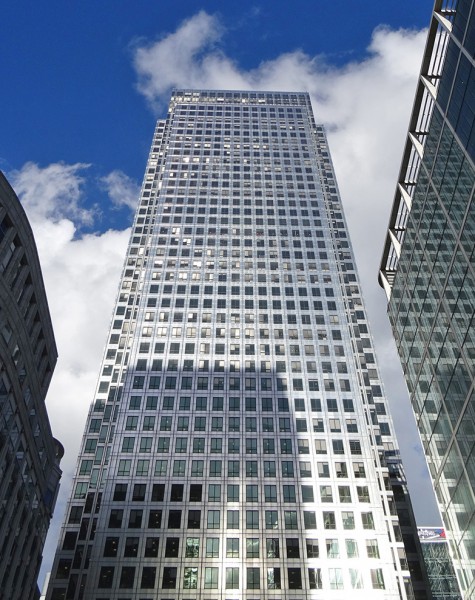 All the articles look at the rise of the rich. The difference with the past is that the people who are gaining the most are not doing so from production but from financial dealing or rental income; they have gained while the real economy has stagnated.
All the articles look at the rise of the rich. The difference with the past is that the people who are gaining the most are not doing so from production but from financial dealing or rental income; they have gained while the real economy has stagnated.
The gains to the rich have come from the rise in the value of assets, such as equities (shares) and property, and from the growth in rental incomes. Only a small fraction of finance is used to fund business investment; the majority is used for lending against existing assets, which then inflates their prices and makes their owners richer. In other words, the capitalist system is moving from driving growth in production to driving the inflation of asset prices and rental incomes.
The process whereby financial markets grow and in turn drive up asset prices is known as ‘financialisation’. Not only is the process moving away from funding productive investment and towards speculative activity, it is leading to a growth in ‘short-termism’. The rewards of senior managers often depend on the price of their companies’ shares. This leads to a focus on short-term profit and a neglect of long-term growth and profitability – to a neglect of investment in R&D and physical capital.
The process of financialisation has been driven by deregulation, financial innovation, the growth in international financial flows and, more recently, by quantitative easing and low interest rates. It has led to a growth in private debt which, in turn, creates more financial instability. The finance industry has become so profitable that even manufacturing companies are moving into the business of finance themselves – often finding it more profitable than their core business. As the Foroohar article states, “the biggest unexplored reason for long-term slower growth is that the financial system has stopped serving the real economy and now serves mainly itself.”
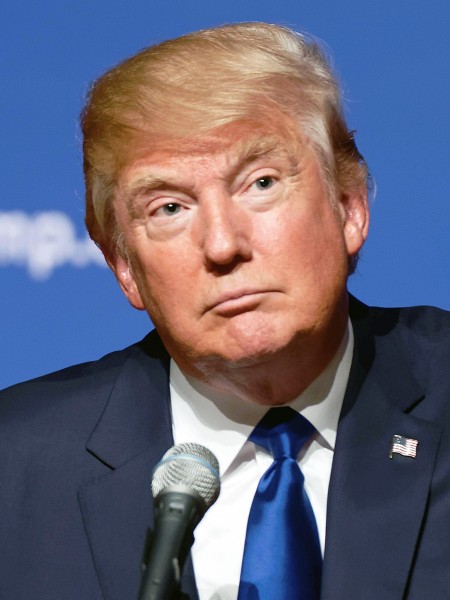 So will the election of Donald Trump, and pressure from populism in other countries too, mean that governments will focus more on production, job creation and poverty reduction? Will there be a movement towards fiscal policy to drive infrastructure spending? Will there be a reining in of loose monetary policy and easy credit?
So will the election of Donald Trump, and pressure from populism in other countries too, mean that governments will focus more on production, job creation and poverty reduction? Will there be a movement towards fiscal policy to drive infrastructure spending? Will there be a reining in of loose monetary policy and easy credit?
Or will addressing the problem of financialisation and the crisis of capitalism result in the rich continuing to get richer at the expense of the poor, but this time through more conventional channels, such as increased production and monopoly profits and tax cuts for the rich? Trump supporters from among the poor hope the answer is no. Those who supported Bernie Sanders in the Democratic primaries think the answer will be yes and that the solution to over financialisation requires more, not less, regulation, a rise in minimum wages and fiscal policies aimed specifically at the poor.
Articles
Can Global Capitalism Be Saved? Project Syndicate, Alexander Friedman (11/11/16)
American Capitalism’s Great Crisis Time, Rana Foroohar (12/5/16)
The Corruption of Capitalism by Guy Standing review – work matters less than what you own The Guardian, Katrina Forrester (26/10/16)
Questions
- Do you agree that capitalism is in crisis? Explain.
- What is meant by financialisation? Why has it grown?
- Will the policies espoused by Donald Trump help to address the problems caused by financialisation?
- What alternative policies are there to those of Trump for addressing the crisis of capitalism?
- Explain Schumpeter’s analysis of creative destruction.
- What technological innovations that are currently taking place could eventually benefit the poor as well as the rich?
- What disincentives are there for companies investing in R&D and new equipment?
- What are the arguments for and against a substantial rise in the minimum wage?
 Many countries have experienced soaring house prices in recent years. To find out why, you need to look at demand and supply.
Many countries have experienced soaring house prices in recent years. To find out why, you need to look at demand and supply.
Low mortgage interest rates and more relaxed lending rules in the last couple of years have stimulated demand. In some countries, such as the UK, demand has been further boosted by governments providing increased help to buyers. In others, various tax breaks are given to house purchasers.
Typically the rise in demand has not been matched by an equivalent rise in supply. Social house building has slowed in many countries and building for private purchase has often be hampered by difficulties in obtaining appropriate land or getting planning permission.
The articles linked below look at the situation in Australia. Here too house prices have been soaring. Over the past 30 years they have grown by 7.25% per year – way above the growth in incomes. As the second article below states:
So expensive are homes becoming that the share of median household income devoted to mortgage payments for Australians aged 35 to 44 has more than doubled in 30 years. Incredibly, it’s happened at a time when mortgage rates have slid to their lowest on record.
But why? Again, to understand this it is necessary to look at demand and supply.
 Strong population growth combined with easy availability of mortgage loans, low interest rates and tax breaks for both owner occupiers and property investors have stoked demand, while new building has lagged behind. As far as investors are concerned, any shortfall of rental income over mortgage payments (known as negative gearing) can be offset against tax – and then there is still the capital gain to be made from any increase in the property’s price.
Strong population growth combined with easy availability of mortgage loans, low interest rates and tax breaks for both owner occupiers and property investors have stoked demand, while new building has lagged behind. As far as investors are concerned, any shortfall of rental income over mortgage payments (known as negative gearing) can be offset against tax – and then there is still the capital gain to be made from any increase in the property’s price.
But in some Australian towns and cities, price rises have started to slow down or even fall. This may be due to a fall in demand. For example, in Perth, the ending of the commodity boom has led to a fall in demand for labour in the mining areas; mine workers often live in Perth and fly up to the mining areas for shifts of a week or more.  The fall in demand for labour has led to a fall in demand for housing.
The fall in demand for labour has led to a fall in demand for housing.
House price changes are amplified by speculation. People rush to buy houses when they think house prices will rise, further pushing up prices. Landlords do the same. This speculation fuels the price rises. Speculation also amplifies price falls, with people with houses to sell keen to sell them quickly before prices fall further. Potential purchasers, including property investors, hold back, waiting for prices to fall.
Articles
House prices are surging because of low supply – it’s Economics 101 The Guardian, Stephen Koukoulas (27/10/16)
Who’s to blame for rising house prices? We are, actually. Sydney Morning Herald, Peter Martin (27/10/16)
The Price of Australia’s Real Estate Boom The New York Times, A. Odysseus Patrick (17/10/16)
Solutions beyond supply to the housing affordability problem The Conversation, Nicole Gurran (24/10/16)
Data
Residential Property Price Indexes: Eight Capital Cities Australian Bureau of Statistics (20/9/16)
Questions
- Identify the specific demand factors that have driven house price rises in Australia.
- How are the price elasticities of demand and supply relevant to explaining house price rises? Use a diagram to illustrate your analysis.
- What determines the rate of increase in house prices?
- Explain what is meant by ‘negative gearing’. How is the tax treatment of negative gearing relevant to the property market?
- What are the arguments for and against giving tax breaks for house purchase?
- Why are rising prices seen as politically desirable by politicians?
- What practical steps could a government (central or local) take to increase the supply of housing? Would such steps always be desirable?
- Does speculation always amplify house price changes? Explain.
- How are house prices related to inequality?
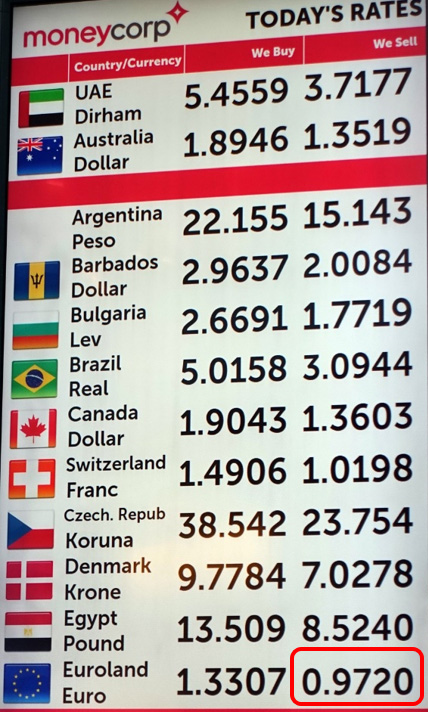
The pound has fallen to its lowest rate against the euro since July 2013 and the lowest rate against the US dollar since 1985. Since August 2015, the pound has depreciated by 23.4% against the euro and 22.2% against the dollar. And since the referendum of 23 June, it has depreciated by 15.6% against the euro and 17.6% against the dollar.
On Sunday 2 October, at the start of the Conservative Party conference, the Prime Minister announced that Article 50, which triggers the Brexit process, would be invoked by the end of March 2017. Worries about what the terms of Brexit would look like put further pressure on the pound: the next day it fell by around 1% and the next day by a further 0.5%.
Then, on 6 October, it was reported that President Hollande was demanding tough Brexit negotiations and the pound dropped significantly further. By 7 October, it was trading at around €1.10 and $1.22. At airports, currency exchange agencies were offering less than €1 per £ (see picture).
With the government implying that Brexit might involve leaving the Single Market, the pound continued falling. On 12 October, the trade-weighted index reached its lowest level since the index was introduced in 1980: below its trough in the depth of the 2008 financial crisis and below the 1993 trough following Britain’s ejection from the European Exchange Rate Mechanism in September 1992.
So just why has the pound fallen so much, both before and after the Brexit vote? (Click here for a PowerPoint of the chart.) And what are the implications for the economy?
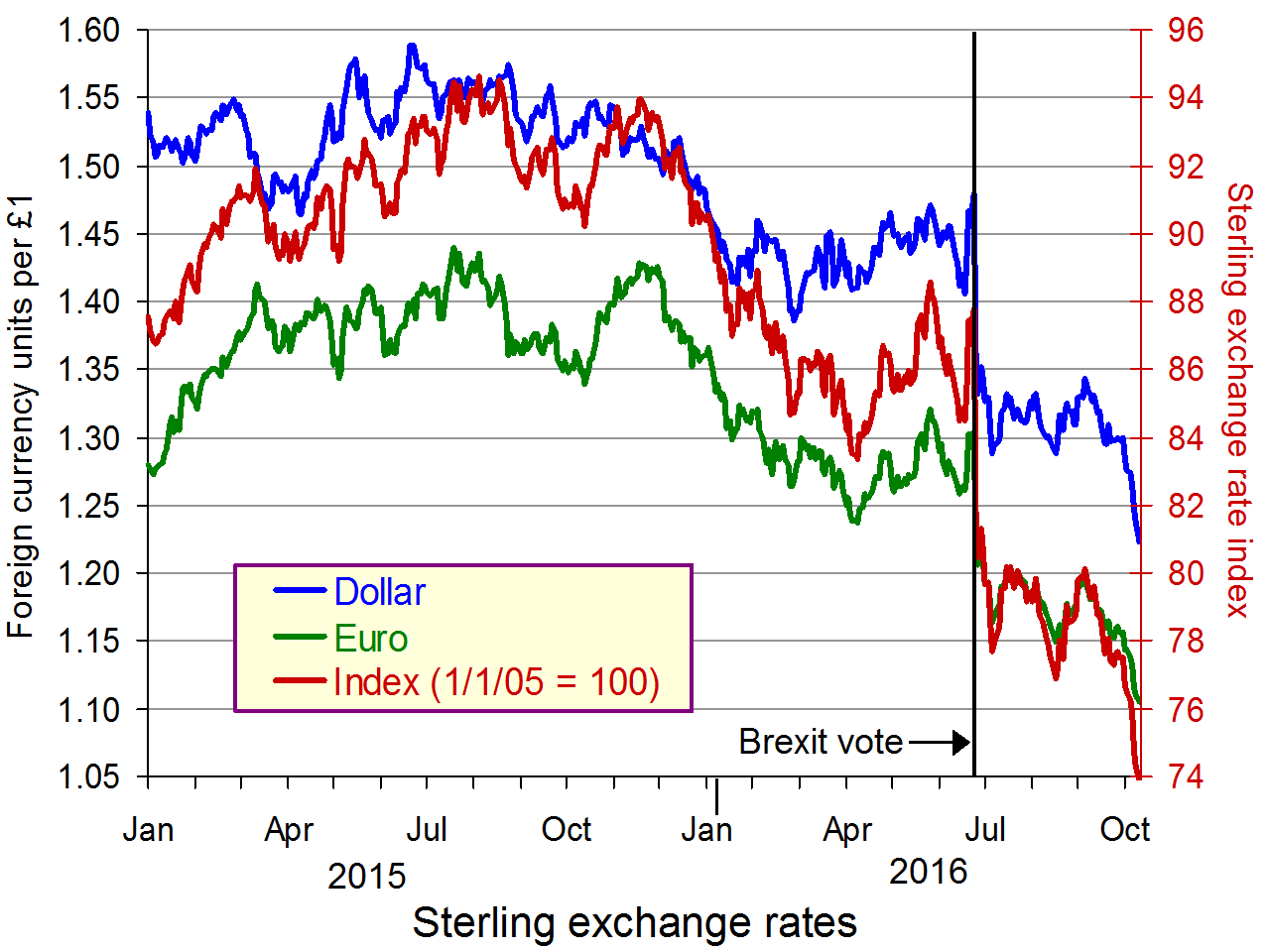 The articles explore the reasons for the depreciation. Central to these are the effects on the balance of payments from a possible decline in inward investment, lower interest rates leading to a net outflow of currency on the financial account, and stimulus measures, both fiscal and monetary, leading to higher imports.
The articles explore the reasons for the depreciation. Central to these are the effects on the balance of payments from a possible decline in inward investment, lower interest rates leading to a net outflow of currency on the financial account, and stimulus measures, both fiscal and monetary, leading to higher imports.
Worries about the economy were occurring before the Brexit vote and this helped to push sterling down in late 2015 and early 2016, as you can see in the chart. This article from The Telegraph of 14 June 2016 explains why.
Despite the short-run effects on the UK economy of the Brexit vote not being as bad as some had predicted, worries remain about the longer-term effects. And these worries are compounded by uncertainty over the Brexit terms.
A lower sterling exchange rate reduces the foreign currency price of UK exports and increases the sterling price of imports. Depending on price elasticities of demand, this should improve the current account of the balance of payments.
These trade effects will help to boost the economy and go some way to countering the fall in investment as businesses, uncertain over the terms of Brexit, hold back on investment in the UK.
Articles
 Pound Nears Three-Decade Low as May Sets Date for Brexit Trigger Bloomberg, Netty Idayu Ismail and Charlotte Ryan (3/10/16)
Pound Nears Three-Decade Low as May Sets Date for Brexit Trigger Bloomberg, Netty Idayu Ismail and Charlotte Ryan (3/10/16)
Sterling near 31-year low against dollar as May sets Brexit start dat Financial Times, Michael Hunter and Roger Blitz (3/10/16)
Sterling hits three-year low against the euro over Brexit worries The Guardian, Katie Allen (3/10/16)
Pound sterling value drops as Theresa May signals ‘hard Brexit’ at Tory conference Independent, Zlata Rodionova (3/10/16)
Pound falls as Theresa May indicates Brexit date BBC News (3/10/16)
The pound bombs and stocks explode over fears of a ‘hard Brexit’ Business Insider UK, Oscar Williams-Grut (3/10/16)
Pound Will Feel Pain as Brexit Clock Ticks Faster Wall Street Journal, Richard Barley (3/10/16)
British Pound to Euro Exchange Rate’s Brexit Breakdown Slows After Positive Manufacturing PMI Halts Decline Currency Watch, Joaquin Monfort (3/10/16)
7 ways the fall in the value of the pound affects us all Independent (4/10/16)
The pound and the fury: Brexit is making Britons poorer, and meaner The Economist, ‘Timekeeper’ (11/10/16)
Is the pound headed for parity v US dollar and euro? Sydney Morning Herald, Jessica Sier (5/10/16)
Flash crash sees the pound gyrate in Asian trading BBC News (7/10/16)
Flash crash hits pound after Hollande remarks Deutsche Welle (7/10/16)
Sterling mayhem gives glimpse into future Reuters, Swaha Pattanaik (7/10/16)
Sterling takes a pounding The Economist, Buttonwood (7/10/16)
Government must commit to fundamental reform The Telegraph, Andrew Sentance (7/10/16)
Data
Interest & exchange rates data – Statistical Interactive Database Bank of England
Questions
- Why has sterling depreciated? Use a demand and supply diagram to illustrate your argument.
- What has determined the size of this depreciation?
- What is meant by the risk premium of holding sterling?
- To what extent has the weaker pound contributed to the better economic performance than was expected immediately after the Brexit vote?
- What factors will determine the value of sterling over the coming months?
- Who gain and who lose from a lower exchange rate?
- What is likely to happen to inflation over the coming months? Explain and consider the implications for monetary and fiscal policy.
- What is a ‘flash crash’. Why was there a flash crash in sterling on Asian markets on 7 October 2016? Is such a flash crash in sterling likely to occur again?
 Your Americano, Latte or Cappuccino may soon be more expensive. This is because coffee bean prices are rising. A combination of continuing growth in demand and poor coffee harvests in various parts of the world have led to a rise in both Arabica and Robusta prices, with the International Coffee Organization’s Composite Indicator price (in US dollars) having risen by over 30% since mid-January this year (see chart below: click here for a PowerPoint)
Your Americano, Latte or Cappuccino may soon be more expensive. This is because coffee bean prices are rising. A combination of continuing growth in demand and poor coffee harvests in various parts of the world have led to a rise in both Arabica and Robusta prices, with the International Coffee Organization’s Composite Indicator price (in US dollars) having risen by over 30% since mid-January this year (see chart below: click here for a PowerPoint)
Supply has been affected by droughts in Brazil and Vietnam, two of the world’s biggest coffee producers, and by pests (the Coffee Berry Borer) in the Kilimanjaro region of Tanzania and in other East African countries. Global exports of coffee in July 2016 were 22% down on the same month in 2015.
The growing shortage and rising current (spot) prices is reflected in future prices. 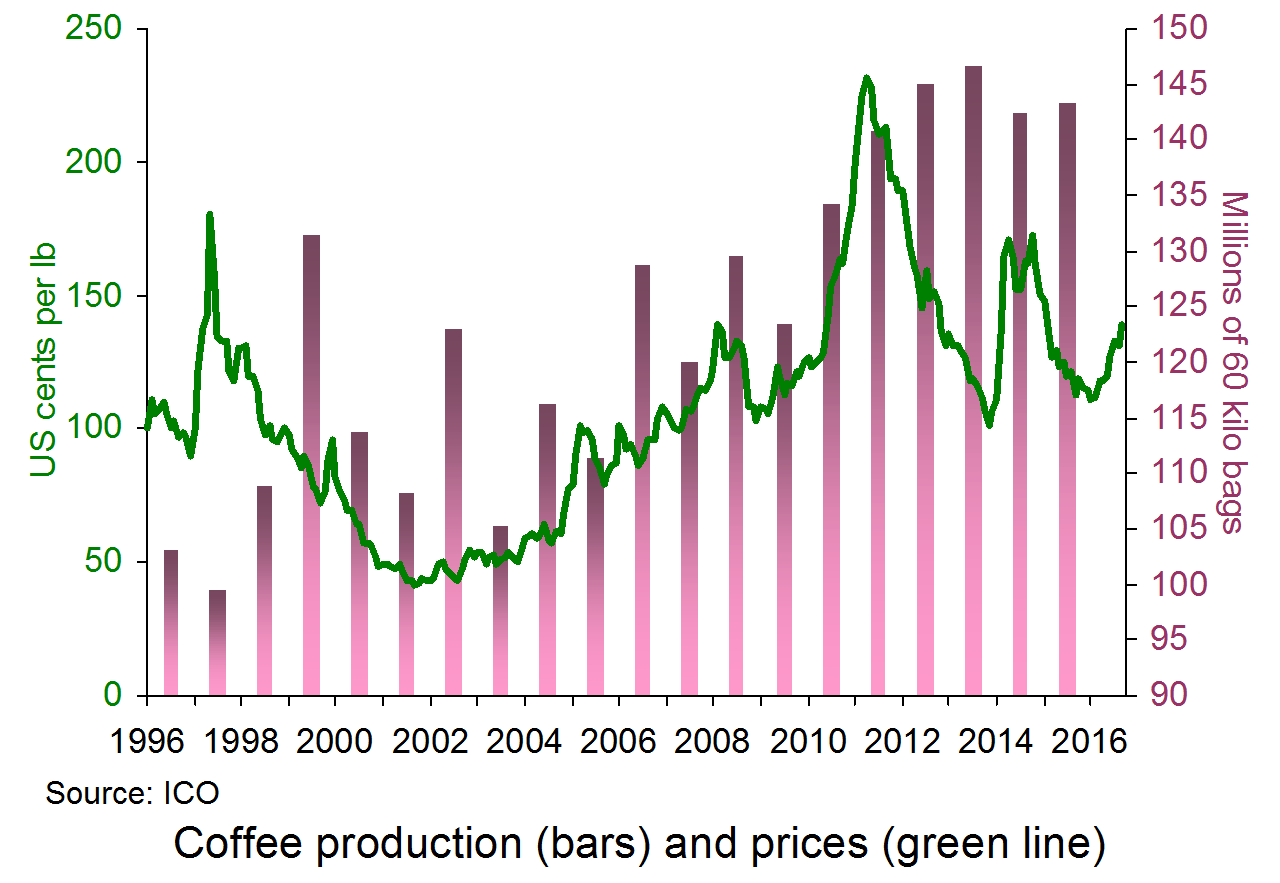 These are prices determined in the market now for trading at a specified future date (e.g. in three months’ time). Future prices depend on predictions of the balance of demand and supply in the future. According to the MarketWatch article below, “Analysts at Société Générale in a note predicted that prices could climb about 30% further by the end of next year”. The current (mid-September) spot price of robusta coffee beans is around $0.96 per lb. The December 2016 future price is around $1.48.
These are prices determined in the market now for trading at a specified future date (e.g. in three months’ time). Future prices depend on predictions of the balance of demand and supply in the future. According to the MarketWatch article below, “Analysts at Société Générale in a note predicted that prices could climb about 30% further by the end of next year”. The current (mid-September) spot price of robusta coffee beans is around $0.96 per lb. The December 2016 future price is around $1.48.
 So what effect will this have on the prices in Starbucks, Costa or Caffè Nero? And what effect will it have on ground or instant coffee in supermarkets? To quote the MarketWatch article again:
So what effect will this have on the prices in Starbucks, Costa or Caffè Nero? And what effect will it have on ground or instant coffee in supermarkets? To quote the MarketWatch article again:
A research report from the US Department of Agriculture found that, on average, a 10% increase in green-coffee-bean prices per pound would yield a 2% increase in both manufacturer prices and at the register in places like Starbucks Corp.
This is because the cost of coffee beans is just one element in the costs of coffee roasters and coffee shops. Also these companies use futures markets to smooth out the prices they pay. They hold stockpiles of coffee, which they build up when prices are low and draw on when prices are high. This helps to reduce fluctuations in retail prices.
So don’t worry too much about the price of your morning coffee – at least, not yet.
Articles
Why a surge in coffee-bean prices may not hit the Starbucks set—yet MarketWatch, Rachel Koning Beals (9/9/16)
Wired coffee prices may not slip far News Markets, David Cottle (9/9/16)
Late-harvest woes prompt Brazil coffee harvest downgrade Agrimoney (7/9/16)
Look Out, Latte Lovers: Brazil Drought Hurts Espresso Beans Bloomberg, Fabiana Batista and Marvin G. Perez (13/9/16)
Why Your Morning Coffee Is About to Become Even More Expensive Fortune (28/7/16)
Climate change brews a storm for East Africa coffee farmers Business Daily (East Africa), Paul Redfern (4/9/16)
Coffee Market Report ICO (August 2016)
Data
Commodity Prices Index Mundi
Historical Data on the Global Coffee Trade ICO
ICO’s Coffee Trade Statistics Infographic for July 2016 ICO blog (31/8/16)
Questions
- What determines coffee futures prices?
- How are the price fluctuations of coffee in coffee shops related to the price elasticities of demand and supply? What determines these elasticities?
- Why does a strengthening (an appreciation) of the currency of a coffee exporter affect (a) the price of coffee to producers in the country; (b) international coffee prices in dollars?
- Are poor coffee harvests on balance good or bad for coffee producers? How does this depend on the market price elasticity of demand? Does the answer vary from producer to producer?
- How does speculation affect coffee prices (both spot and future)? Is such speculation of benefit to (a) the coffee consumer; (b) the coffee grower?
 OPEC members agreed on 30 November 2016 to reduce their total oil output by 1.2m barrels per day (b/d) from January 2017 – the first OPEC cut since 2008. The biggest cut (0.49m b/d) is to be made by Saudi Arabia.
OPEC members agreed on 30 November 2016 to reduce their total oil output by 1.2m barrels per day (b/d) from January 2017 – the first OPEC cut since 2008. The biggest cut (0.49m b/d) is to be made by Saudi Arabia. The OPEC agreement took many commentators by surprise, who had expected that Iran’s unwillingness to cut its output would prevent any deal being reached. As it turned out, Iran agreed to freeze its output at current levels.
The OPEC agreement took many commentators by surprise, who had expected that Iran’s unwillingness to cut its output would prevent any deal being reached. As it turned out, Iran agreed to freeze its output at current levels. The deal represented a U-turn by Saudi Arabia, which had previously pursued the policy of not cutting output, so as to keep oil prices down and drive many shale oil producers out of business (see the blog, Will there be an oil price rebound?)
The deal represented a U-turn by Saudi Arabia, which had previously pursued the policy of not cutting output, so as to keep oil prices down and drive many shale oil producers out of business (see the blog, Will there be an oil price rebound?)  OPEC Cuts Daily Production by 1.2 Million Barrels MarketWatch, Sarah Kent (30/11/16)
OPEC Cuts Daily Production by 1.2 Million Barrels MarketWatch, Sarah Kent (30/11/16) How Putin, Khamenei and Saudi prince got OPEC deal done Reuters, Rania El Gamal, Parisa Hafezi and Dmitry Zhdannikov (2/12/16)
How Putin, Khamenei and Saudi prince got OPEC deal done Reuters, Rania El Gamal, Parisa Hafezi and Dmitry Zhdannikov (2/12/16) Fuel price fears as OPEC agrees to cut supply Sky News, Colin Smith (30/11/16)
Fuel price fears as OPEC agrees to cut supply Sky News, Colin Smith (30/11/16) OPEC Confounds Skeptics, Agrees to First Oil Cuts in 8 Years Bloomberg, Jamie Webster (30/11/16)
OPEC Confounds Skeptics, Agrees to First Oil Cuts in 8 Years Bloomberg, Jamie Webster (30/11/16) Game of oil: Behind the OPEC deal Aljazeera, Giacomo Luciani (3/12/16) (first 10½ minutes)
Game of oil: Behind the OPEC deal Aljazeera, Giacomo Luciani (3/12/16) (first 10½ minutes) Russia won’t stick with its side of the OPEC cut bargain CNBC, Silvia Amaro (1/12/16)
Russia won’t stick with its side of the OPEC cut bargain CNBC, Silvia Amaro (1/12/16)









